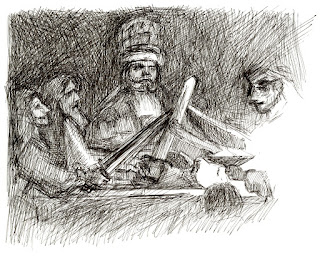Claudius Civilis
This is a reproduction of one of my sketchbook drawings from Rembrandt's Conspiracy of Claudius Civilis. I got to see the painting in June of 2016 when it was on loan to the Rijksmuseum in Amsterdam, while the National Museum of Sweden was being renovated. I expect that the painting is back in Stockholm now, as the museum is scheduled to reopen soon.
I have been looking at and thinking about the work of
Rembrandt and his students, noting a difference in the boldness of the
execution. Rembrandt worked vigorously and freely, his students more cautiously. But, like his students, Rembrandt was precise in his shaping and placement of forms.
Precision seems to have been demanded by Dutch art patrons
of the day. From the exquisite still life paintings of the Dutch ‘little
masters’, to the figure paintings of Ter Borch and the church interiors of
Sanraedam, it seems that the best images had to function like a watch, or a
scientific instrument. Forms needed to be described accurately, and in small
detail. But, more than that, in the work from that period that excites me most,
the forms needed to be arranged in designs that convey movement and liveliness.
Later in his life Rembrandt left his paintings in a rougher state of finish, and his work fell out of favor. I am among the enthusiasts of his work today who are grateful for his willingness to press on with his artistic mission, despite waning popularity.
The Claudius Civilis was something of a disaster for Rembrandt. It was a huge painting commissioned for the new town hall, but the work was rejected. He cut the canvas down to its present dimensions, to see if he could sell it to someone else, but was not able to do so.
When I was younger, back in high school and college, the Claudius Civilis was probably my favorite Rembrandt painting. I would study it in book reproductions, and think about how great it would be to see in person. The dramatic lighting, and rough appearance of the figures were probably what captured my attention.
But by the time I got to see it in person, I didn't respond to it as strongly. The drawing and overall design seem a bit off, lacking in the precision that I usually find in his work. I expect that the elements we can see today felt more at home in their original format, a huge canvas with theatrical space and architecture around the figures.
Rembrandt's sketch of the painting's original composition, along with interesting background information, can be seen on Wikipedia:




Comments
Post a Comment